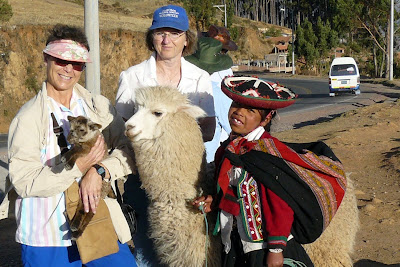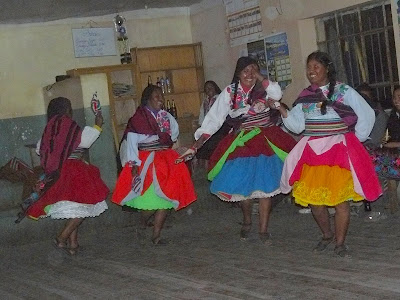


Pat and Cornelia with Lamas and native girl
Native girls dyeing the wool
At Machu Picchu
Alpaca with owner
Native girls dyeing the wool
At Machu Picchu
Alpaca with owner
Part 1 Machu Picchu
We left the heat and humidity of the jungle for another extreme - high altitude and very dry - when we flew from Iquitos to Cusco, via Lima. Cusco sits at 10,200 feet. Needless to say we were not acclimated to the altitude, but as soon as we landed we were off on a guided tour of the Incan ruins in the hills surrounding Cusco. Cornelia and I had problems adjusting to this altitude. I can’t say I got much out of this tour other than shortness of breath and a tingling in my hands. Even with altitude pills and coco tea, I didn’t get much relief until we descended by van to the Sacred Valley the next day. Here there were more ruins to explore, more long steep staircases to climb. Fortunately, due to the downturn in the economy and tourism, we were upgrade to the Rio Sagrado Hotel Villas and Spa. It was a beautiful spot and we caught up on our rest. The next day we boarded the train for an hour and a half ride to Aguas Calientes. From here we took a bus up the side of the mountain to the entrance of Machu Picchu.
We were lucky to get an excellent guide for this portion of the trip. He helped recreate the history and explained the symbolism in the temples. We all walked the final portion of the Inca Trail before entering the passageway into Machu Picchu. After the guided tour and lunch, Pat walked the Inca Trail up to the Gate of the Sun, the first place that hikers get to see Machu Picchu. The rest of us continued to tour the remainder of the ruins. Instead of that mystical feeling that some people get here, my stomach was giving me very disturbing feelings. Back at the hotel, I passed on going out to dinner. Pat planned to bring me some chicken soup back for dinner. I guess carry out is not a concept that has caught on here. The waiter carried a large fancy bowl of soup five blocks to our hotel, carried it up the stairs to the third floor and delivered it to me in our room. He waited in the lobby for 45 min, then he returned to pick up the bowl. The next morning the hotel manager fixed up a mixture of three teas to help settle my stomach and allowed us to stay in our hotel room a few extra hours. We took the afternoon train back to Cusco. Here we said goodbye to Tom and Cornelia, who returned home.
We were lucky to get an excellent guide for this portion of the trip. He helped recreate the history and explained the symbolism in the temples. We all walked the final portion of the Inca Trail before entering the passageway into Machu Picchu. After the guided tour and lunch, Pat walked the Inca Trail up to the Gate of the Sun, the first place that hikers get to see Machu Picchu. The rest of us continued to tour the remainder of the ruins. Instead of that mystical feeling that some people get here, my stomach was giving me very disturbing feelings. Back at the hotel, I passed on going out to dinner. Pat planned to bring me some chicken soup back for dinner. I guess carry out is not a concept that has caught on here. The waiter carried a large fancy bowl of soup five blocks to our hotel, carried it up the stairs to the third floor and delivered it to me in our room. He waited in the lobby for 45 min, then he returned to pick up the bowl. The next morning the hotel manager fixed up a mixture of three teas to help settle my stomach and allowed us to stay in our hotel room a few extra hours. We took the afternoon train back to Cusco. Here we said goodbye to Tom and Cornelia, who returned home.
















































